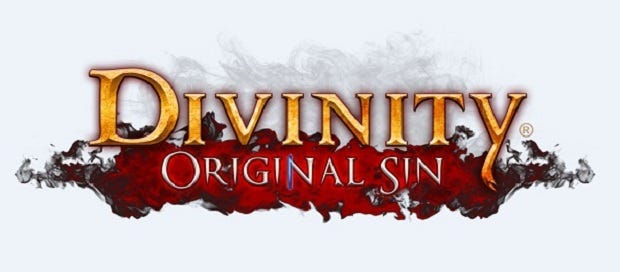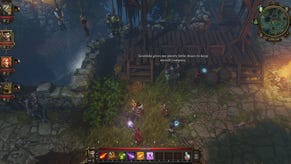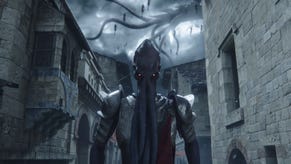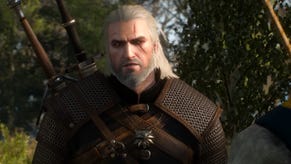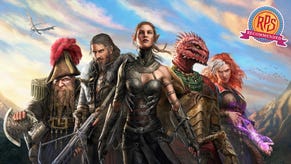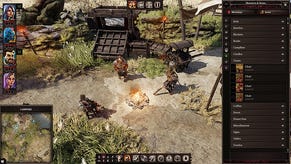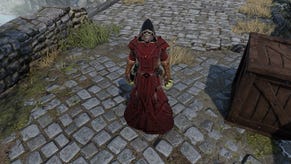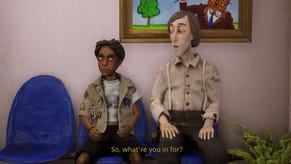Wot I Think: Divinity - Original Sin
Divine operating systems
Some RPGs are built around systems and some are built around scripts. Divinity: Original Sin is an example of the former and its one of the finest I've ever seen. Oops. Gave away the ending. Larian's lates is a single or two-player cooperative RPG with turn-based combat, crafting and an enormous world full of objects to interact with and NPCs to converse with or kill. No knowledge of previous Divinity games is required but an appreciation of the older school of roleplaying may help you to acquire this particular taste.
It's a sprawling game, responsible for some of the most interesting experiences I've had in all my years of gaming. I could write about it for weeks but I've limited myself to a single feature. For now. It's broken up into three parts, all of which are below.
Part 1 - Sausages and Steak
Sometimes this world of games and the role of critic within it can be very kind and fulfilling. The release of Divinity: Original Sin marks just such an occasion.
As Early Access becomes increasingly common, I’m becoming accustomed to comments on articles like the Pillars Of Eternity news from earlier today – ‘why would I want to play a story-driven game before it’s finished?’ I am as one with the people who make those comments. It’s strange to work as a critic in a creative field where unfinished work is constantly and eagerly exposed to you. Imagine Stanley Kubrick inviting a pack of critics to the set of 2001 and then sitting with them as they watched early rushes of key scenes while trying to justify himself in the face of weary questioning.
How instructive can a trip to the sausage factory be? The risk, so often, is that we watch the hairy hogflesh falling into the grinder, tubing out like tingling pink toothpaste, and imagine that’ll it’ll somehow become a tender cut of Matsusake beef steak. We see the thing being made and cannot help but think how succulent the final result might be, when the blood pudding of placeholder assets has been sloughed away and the process has been refined. Peering through the veined membrane of the abattoir blues is part of the job.
I first saw Divinity: Original Sin in March, 2013. I was in London, at the Walkabout pub by Temple station. Larian had brought two games across from Belgium and I wanted to get my hands on the one that featured dragons wearing jetpacks. I knew that the Original Sin code was quite early and I didn’t have any particular attachment to the series, having only played Divine Divinity, and that many years before and briefly.
You can read the impressions I wrote up afterwards. The intro sums it up best. I remember speaking to Swen Vincke, Larian’s CEO, right after playing – I mentioned Ultima VII and it became obvious we could have talked for hours about the intricacies of the game and its systems. How it contained crafting without needing to contain a menu or prompt for the verb, and how the NPCs followed schedules and seemed to exist.
Vincke seemed pleased that I’d picked up on the influence but I also realised I’d found someone who recognised what a high bar that game sets. He told me of the things he wanted the team to integrate, the level of simulation he’d chase given the time and funds. Excited, but apprehensive, he told me that a Kickstarter was planned, with the hope that the extra money would allow the scope of the game to expand.
In early 2013, Larian showed me mincemeat, and then I sat down with Vincke to talk about steak.
Part 2 - In Ghent
I’d never been to Belgium before when I travelled to Ghent in December of last year. Vincke had been at a meeting near the airport and picked me up to take me straight to Larian’s offices. That’s the wrong word, ‘offices’ – Larian have an open plan workspace with arcade and pinball machines, and a (sadly broken at the time) set of draught beer pumps in the foyer.
We talked about beer in the car. When in Belgium it’s rude not to. Vincke recommended a particular Trappist brew, which I’ve since forgotten. We talked about football too and Belgium’s World Cup hopes. Even back then, I found the idea of England making any progress hilarious.
And then one of us mentioned Ultima VII again. The conversation picked up almost exactly where we’d left it in March. Vincke didn’t seem as intimidated by the comparison now and was eager to see if Original Sin would live up to expectations.
Ghent is beautiful. Maybe. I saw more of the city during that initial car trip than I did during the remaining 48 hours of my visit. It may not be a fairytale town but it has enough medieval memories to soothe the eyes and the area around the studio is dotted with picturesque churches. I planned to explore a little, as I always do if I find myself in a new city, but it was not to be. I played Original Sin for two days straight, breaking to eat, drink, talk and (briefly) sleep, and I left in high spirits. My account of those two days, which involved bucket-hats, detective agencies and the hunt for a potato, is here.
Of all the things that I saw, the one that stuck with me during the trip home was a sign attached to the wall that every employee passed on the way to their desk – “Why can the player move a flowerpot? Because it’s there.”
Chapter 3 - Wot I Really Really Think
I didn’t play Original Sin during its stint in Early Access. Having explored the early game in some detail, I was determined to wait for the finished article before I jumped back in. I wouldn’t normally tell you wot I think before playing a game to completion but after sinking far too many hours into the game this week, I’m ready to share my thoughts, which are tied up in those earlier experiences and the expectations that built up on the back of them.
They’re the kind of expectations that could break the back of an accomplished piece of work and there have been times when I’ve tried to push them to one side. The good news is, I didn’t need to. In a year that will see a big return on my kind of RPG – less Bethesda and Bioware, more Obsidian and Black Isle – I’ll be shocked if this isn’t the best of them. The writing is strong, character development encourages play and experimentation, and the world is a toy.
Original Sin is like a Lego set. I might never build the architecture or the scene shown on the box, but I’ll make a thousand other things along the way. It’s a game that encourages the player to follow or invent tangents and diversions, and that provides its inhabitants with enough simulated agency to convince that they’re willing to engage with those diversions. Perhaps Pillars Of Eternity or Wasteland 2 will have a finer end-goal for their kit – a handsome attempt at perfection - but will the pieces be as fun to muddle and confuse?
The basic blocks are simple. Turn-based combat, which makes clever use of the elements, has character attributes, skills and equipment as its foundation. Classes can be selected for both of the player characters at the start of the game but every aspect can be customised if you don’t want to stick to templates. Original Sin is the rare RPG I which I’m happy to play as a magic user.
I normally avoid the beardy blighters because I don’t like managing spell memorisation systems and mana regeneration. Small and puny I may be, but I’m a barbarian at heart. Original Sin provides every character with skills, operated from a bar at the bottom of the screen, and those skills have a cooldown. My knight uses magic but if he’s out of spell-juice, he can resort to special melee attacks that allow him to engage tactically or change the field of play. Wizards are high maintenance compared to the cheap date that is my barbarous self, but they can still weigh in, even without constant attention and resources.
Levelling up allows you to improve basic attributes so that you can use all the tasty loot you’ve found but also unlocks traits. These are fun. Pet Pal is the obvious example to highlight the game’s silly streak (several miles wide) and determination to provide interesting content in every corner of its world.
Choosing Pet Pal allows a character to talk to animals. A gimmick that makes me feel guilty when I kill a rat to gain a few paltry experience points. If that were all it achieved, I’d probably still take it because I mostly enjoy Larian’s sense of humour and the occasional conversation with a cow is entertaining during countryside questing. But then, during the game’s first major quest, there’s one solution among several that can only be followed by dog whisperers. And an entire sidequest about romantic cats that Don’tLittles will never see.
The philosophy that drives the game is the one that was posted on Larian’s wall, an extension of the movable plant pots. If it’s in the world, allow the player to play with it.
Other happy surprises emerge at a steady clip. Revisiting the opening areas, I’ve found so much more than was evident during my first and second visits. More NPCs with more to say, more sidequests and loot locations, and more ways to push at and explore the systems that drive the world. That’s the key difference between Original Sin and most other RPGs – the world, its objects and its creatures are designed to work within systems. There’s scripting aplenty but those willing and able to improvise will find the greatest rewards.
Elemental concerns elevate the combat and allow for the experimental tendencies that the rest of the game supports to come to the fore. Cause an orc to bleed and then freeze its blood so that other orcs slip, slide and fall on their arses as they charge across it. Create noxious poison clouds and then ignite them with a fireball. Make the heavens open on an unsuspecting bandit and then strike his sodden backside with lightning. There are careful combos to discover and there is chaos to unleash.
And then there’s the crafting. More experimentation. Combine items to create something new, including the fish and chips that I hunted for so long in Ghent. There are stories to be written about the great chefs of Original Sin as well as the great artefact hunters. I want to live many lives in this world and I want to read about the ones that pass me by. It may not quite be Ultima VII Part 3 (nor does it aspire to be exactly that) but a decade or two from now, somebody will write about its roads and taverns with similarly fond memories.
In all of this, I’ve skipped over the game’s exquisite multiplayer mode and there’s a reason for that. There are always two player characters and a single player will be responsible for both during combat and exploration. Again, this encourages exploration of different character builds and makes odd choices less punishing should they turn out to be a bit rubbish. It’s in conversation that the two-character system shows its smarts though.
Playing alone, a companion can have one of three AI settings – ‘none’, ‘loyal’ or ‘random’. The first allows the player to choose dialogue when disagreements occur, roleplaying both characters or deliberately trying to shape them for some wicked end. Loyal characters will always agree with the player, removing any possible friction (not of the Bioware companion romance variety) and random AI will create its own character by being entirely unpredictable.
These choices occur during dual dialogues, situations when the characters have to make a moral decision or pass comment on some occurrence within the world. They might comment on a matter of faith or law, or discuss how to deal with a twist in the tale. The decisions can lead to bickering, which is amplified when playing with another human being. It becomes real world bickering, about the personalities of the players and the roles they’re choosing to adopt.
I wish there were more of it because every time a dialogue begins, I rub my hands together in anticipation of the sweet drops of character development that follow. The reason I’m not writing more about the multiplayer right now is because we’ll be discussing it in more depth at a later date, when we’ve had more of a chance to pit our personalities against one another in anticipation of a verdict. The verdict may be on our own morality and playstyles as well as the game.
This entire feature could have been about the multiplayer experience. It could have been about the shocks and surprises that the combat still manages to throw in my face. Hell, I could have at least spent a paragraph or two on the Homestead and the End of Time, but you'll discover all of that for yourself. I could even have written a thousand words or more about the pride I take in my expanding recipe book. Original Sin is that kind of game. One to be chewed on, mused over and digested at length.
As good as the game is, I do have a few complaints. The loot system isn’t as interesting as I’d hoped, with only the occasional exciting or esoteric item turning up during exploration off the beaten path. And the main questline, while mostly strong, isn’t quite as weird and wonderful as some of the more delicious branching side stories. It’s enormous though and the game is packed with content. I’d have liked the world to be larger rather than quite so dense, mostly because I enjoy investigating the places in between dollops of written content, but there are so many things to see and do.
The journey has been a long one and I’m pleased that the ending is a happy one. At the beginning of these thoughts I said that the role of critic can be kind and fulfilling. That’s because for all of the ideas that I admired in that early build more than a year ago, I suspected that the best of them might fall apart as the game grew in size and complexity. Against strong odds, Larian have fulfilled the early promise and the extra time, effort and money has all been invested wisely. The sausage has become a steak, succulent and flavoursome, and I have a new toy to play with and return to over the coming months and years.
Divinity: Original Sin is available now.
